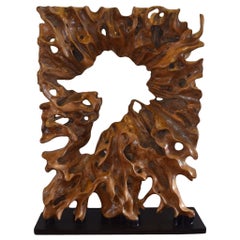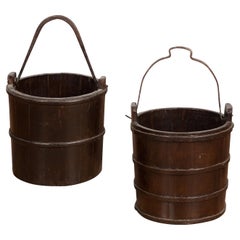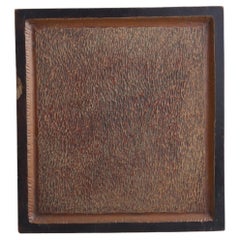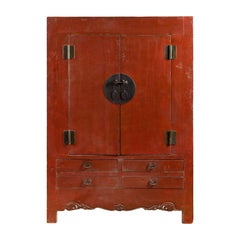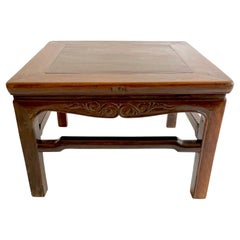Wood More Asian Art, Objects and Furniture
to
74
414
366
790
30
16
12
11
5
4
3
2
1
1
123
393
274
46
146
74
11
18
3
2
4
9
5
3
1
1
836
681
372
171
152
741
326
309
270
229
836
825
825
19
8
2
2
2
Material: Wood
Andrianna Shamaris Single Teak Wood Root Sculpture on Modern Steel Base
Located in New York, NY
Beautiful hand-carved sculpture from a single reclaimed teak wood root. Beautiful on both sides. Set on a modern black steel base.
Own an Andrianna Shamaris original.
Andrianna Sha...
Category
2010s Modern Wood More Asian Art, Objects and Furniture
Materials
Wood, Teak, Reclaimed Wood
19th Century Wooden Well Buckets with Dark Brown Lacquer, Sold Each
Located in Yonkers, NY
Two antique Chinese Qing Dynasty period wooden dark brown lacquered well buckets from the 19th century, with large metal handles and horizontal braces, priced and sold individually. These antique Chinese wooden dark brown lacquered well buckets from the 19th century exude a sense of history, charm, and rustic beauty. Each bucket showcases a dark brown lacquer finish that highlights the character of the wood, evoking a sense of warmth and authenticity. These well buckets, priced and sold individually, are a testament to the skilled craftsmanship and timeless design of the 19th century.
The buckets feature large metal handles, forged and designed for practical use, while adding a touch of rugged elegance to the overall aesthetic. Horizontal metal braces wrap around the circumference of each bucket, not only providing structural support but also enhancing the visual interest of these unique pieces. The metal elements contrast beautifully with the dark lacquer, creating a harmonious interplay between the materials.
These antique Chinese well buckets...
Category
19th Century Chinese Qing Antique Wood More Asian Art, Objects and Furniture
Materials
Metal
Japanese Antique Wood Carving Wall Panel, Abstract Art , Wabi Sabi
Located in Katori-Shi, 12
This wall-hanging carved wooden ornament is made from recycled zelkova wood from a kotatsu table from the Meiji period.
The beautiful grain of the wood has been carefully carved by ...
Category
Early 20th Century Japanese Meiji Wood More Asian Art, Objects and Furniture
Materials
Wood
Chinese 19th Century Qing Dynasty Red Lacquer Cabinet with Medallion Hardware
Located in Yonkers, NY
A Chinese Qing Dynasty period red lacquered cabinet from the 19th century, with round medallion hardware and drawers. We have a pair available should you need it (see image 3 for instance), however each cabinet is priced $5,500. Created in China during the Qing Dynasty period, this cabinet features a linear silhouette perfectly complimented by a red lacquered finish. A pair of double doors, fitted with a large medallion, opens to reveal a dark interior made of inner shelves and two hidden drawers offering convenient storage options. The lower section showcases four additional drawers while the ensemble is raised on four straight legs connected to one another through a carved apron in the front. With its clean lines and red finish, this 19th century Chinese Qing cabinet...
Category
19th Century Chinese Qing Antique Wood More Asian Art, Objects and Furniture
Materials
Metal
Geisha Wig & Nô Theater 2 Mask
Located in Paris, FR
Mask Geisha Wig & Nô Theater 2, with real natural hair Geisha wig
on head model and with Nô Theater natural wood mask.
Base: 28,5x26,3cm.
Category
1950s Japanese Vintage Wood More Asian Art, Objects and Furniture
Materials
Wood
19th Century Chinese Ironwood (Teilimu) Kang Table
Located in Atlanta, GA
This 19th century kang table is rare because of the wood it’s carved from, Ironwood. Teilimu, Chinese Ironwood is a slow growing dense hardwood that i...
Category
Mid-19th Century Chinese Antique Wood More Asian Art, Objects and Furniture
Materials
Hardwood
Vintage Moorish Box Mosaic Marquetry
Located in North Hollywood, CA
Exquisite handcrafted Middle Eastern Lebanese mosaic marquetry wood box.
Small octagonal walnut Syrian style box intricately decorated with Moorish...
Category
Mid-20th Century Lebanese Moorish Wood More Asian Art, Objects and Furniture
Materials
Shell, Fruitwood, Abalone, Mother-of-Pearl
16th-Century Indo-Portuguese Colonial Mother-of-pearl Gujarat Casket
Located in Amsterdam, NL
An exceptional Indo-Portuguese colonial mother-of-pearl veneered casket with silver mounts
India, Gujarat, 2nd half of the 16th century, the silver mounts Goa or probably Lisbon
Measures: H. 16 x W. 24.6 x D. 16.1 cm
An exceptional Gujarati casket with a rectangular box and truncated pyramidal lid (with slopes on each side and a flat top) made from exotic wood, probably teak (Tectona grandis), covered with a mother-of-pearl mosaic. The tesserae, cut from the shell of the green turban sea snail (Turbo marmoratus, a marine gastropod) in the shape of fish scales, are pinned to the wooden structure with silver ball-headed nails. The casket is set on bracket feet on the corners. The masterfully engraved decoration of the silver mounts follows the most refined and erudite Mannerist repertoire of rinceaux and ferroneries dating from the mid-16th century. The high quality and refinement of the silver mounts and, likewise, the silver nails that replaced the original brass pins used to hold the mother-of-pearl tesserae in place indicate the work of a silversmith probably working in Lisbon in the second half of the 16th century.
The Indian origin of this production, namely from Cambay (Khambhat) and Surat in the present state of Gujarat in north India, is, as for the last three decades, consensual and fully demonstrated, not only by documentary and literary evidence - such as descriptions, travelogues and contemporary archival documentation - but also by the survival in situ of 16th-century wooden structures covered in mother-of-pearl tesserae. A fine example is a canopy decorating the tomb (dargah) of the Sufi saint, Sheik Salim Chisti (1478-1572) in Fatehpur Sikri in Agra district in the state of Uttar Pradesh, north India. This is an artistic production, geometric in character and Islamic in nature, where usually the mother-of-pearl tesserae form complex designs of fish scales or, similar to the dishes also made using the same technique, with the thin brass sheets and pins, stylized lotus flowers. The truncated pyramidal shape corresponds, like their contemporary tortoiseshell counterparts also made in Gujarat, to a piece of furniture used in the Indian subcontinent within the Islamic world prior to the arrival of the first Portuguese. This shape, in fact, is very old and peculiar to East-Asian caskets, chests or boxes used to contain and protect Buddhist texts, the sutras.
A similar chest is the famous and large reliquary chest from Lisbon cathedral that once contained the relics of the city's patron saint, Saint Vincent. Both match in shape, having the same kind of socle or pedestal and bracket feet, and in their engraved silver mountings, featuring the same type of refined, erudite decoration. Their differences lie in the silver borders that frame the entire length of the edges of the chest (both the box and the lid), pinned with silver nails, and on the lock plate, shaped like a coat of arms in the Lisbon example. Given the exceptional dimensions of the reliquary casket...
Category
16th Century Indian Antique Wood More Asian Art, Objects and Furniture
Materials
Silver
Very large and special antique Buddha statue from Burma
Located in DEVENTER, NL
This Very large and special antique Buddha statue is a truly unique and special collectible piece. Made of wood, this statue stands at 139 cm hi...
Category
19th Century Burmese Antique Wood More Asian Art, Objects and Furniture
Materials
Wood
Sale is for the 2 Antique Chinese Water Buckets in Dark and Light Wood
Located in Markington, GB
2 antique Chinese water bucket in dark and light wood
Measures: Height: 58cm, depth: 34cm, width: 34cm.
Category
Early 1900s Chinese Late Victorian Antique Wood More Asian Art, Objects and Furniture
Materials
Wood
$202 Sale Price
62% Off
Anglo-Indian Vizagapatam Bombay Mughal Style Footed Box With Bone Overlay
Located in North Hollywood, CA
Nice and unusual Indian Mughal style large decorative box, filigree and carved horn.
Anglo-Indian footed domed box with exceptional engraved details throughout with filigree and carved veneered bone plaques with arabesque carving.
Vizagapatam, late 19th century.
History of the Anglo-Indian Boxes
Beginning in the early part of the 18th century, Indian artisans made what came to be known as Anglo-Indian boxes for the English residents living in India, who eventually brought or sent them back to England. At the beginning of the 19th century, India began exporting these boxes commercially, although not in any significant numbers until the 1850s. People valued them so highly that manufacturers of tins copied the designs on them in the late 19th and early 20th century.
Anglo-Indian boxes fall into four groups: Rosewood or ebony boxes inlaid;
sandalwood boxes veneered; sandalwood boxes covered with Sadeli mosaic; and carved boxes often combined with Sadeli mosaic/
The first two categories came from Vizagapatam in East India while the last two came from Bombay in West India.
English traders discovered the rich woods and intricate workmanship of Indian artisans, so colonial government officials began to recognize the work of the Indian artists and craftsmen as a source for satisfying the need for furniture and boxes, which would both serve to enhance English households in India. This gave rise to the cabinetmaking workshops in Vizagapatam between Calcutta and Madras.
Craftsmen made the first boxes to be decorated with Sadeli mosaic of rosewood or ebony, incised to give further definition to the decoration, directly inlaid into the wood. The shape of the early boxes was either sloping at the front with a flatter section at the back, reminiscent of English writing slopes, or rectangular. Artisans inlaid the borders with stylized floral scrolls and the centers with a single floral motif following a circular or oval symmetrical or asymmetrical pattern. The edging was ornamental and protective, both helped protect the end grain against the weather.
Made in Vizagapatam, situated on the south east coast of India, near Madras
These exotic boxes...
Category
Late 19th Century Indian Anglo Raj Antique Wood More Asian Art, Objects and Furniture
Materials
Wood
Miniature Huanghuali Wood Chinese Sideboard
Located in New York, NY
Miniature Huanghuali wood Chinese sideboard. An expertly crafted miniature architectural model in Huanhuali wood with brass hardware. A late 20th centu...
Category
Late 20th Century Chinese Qing Wood More Asian Art, Objects and Furniture
Materials
Rosewood
Anglo Raj Hand-Carved Decorative Jewelry Box
By Rajhastani
Located in North Hollywood, CA
Hand-carved Anglo Raj early 20th century carved wood box richly decorated overall with arabesques and floral carving.
Hinged lid shallow relief carving with interior lined with red r...
Category
Early 20th Century Indian Anglo Raj Wood More Asian Art, Objects and Furniture
Materials
Sandalwood
19th Century Asian Wooden Decorative Storage Box
Located in Germantown, MD
Mid 19th Century Asian Wooden decorative storage box with lid.
Measures 13.5"W x 11"D x 11.5"H.
Category
Mid-19th Century Chinese Chinese Export Antique Wood More Asian Art, Objects and Furniture
Materials
Metal
$682 Sale Price
30% Off
Burmese Wood, Bone and Brass Tobacco Pipe, Late 19th Century
Located in New York, NY
A large tobacco pipe from old Burma (Myanmar), circa 1850. Solid wood bowl, chamber and shank. The stem is made of bone, attached to the shank by a mor...
Category
1850s Burmese Other Antique Wood More Asian Art, Objects and Furniture
Materials
Brass
Mosaic Marquetry Octagonal Music Box Granada Moorish Spain
Located in North Hollywood, CA
Exquisite handcrafted vintage Middle Eastern style mosaic marquetry inlaid walnut wood footed music box.
Handcrafted in Spain in the Moorish Syrian style with red velvet lined and a mirror.
Decorative Spanish inlaid Marquetry music box intricately and finely inlaid in Islamic geometric designs with marquetry of precious wood decorated with Moorish Islamic motif designs which have been painstakingly inlaid with fruitwoods.
Small octagonal walnut Syrian style box intricately decorated with mosaic marquetry.
Handcrafted in Granada Spain...
Category
Mid-20th Century Spanish Moorish Wood More Asian Art, Objects and Furniture
Materials
Shell, Fruitwood
Japanese Large Hand Carved Wooden Bear Family With Salmon 33 Inches, Signed
Located in South Burlington, VT
Japanese fine old handmade and hand carved wood bear parent and child "Higuma" carrying their catch of the day a "salmon" fish.
Artist signed Seiho.
Handcrafted from cryptomeria (c...
Category
Mid-20th Century Japanese Showa Wood More Asian Art, Objects and Furniture
Materials
Cedar
$1,900 Sale Price
32% Off
Rare Indo-Portuguese Carved Iconographic Coconut
Located in Spring Valley, NY
This rare and unusual object is a hand-carved coconut done in the Indian city of Goa, during the era of Portuguese colonization. The workmanship of the exquisite carving is superb in...
Category
Late 18th Century Indian Antique Wood More Asian Art, Objects and Furniture
Materials
Coconut
$6,800 Sale Price
45% Off
Colonial Islamic Arabian Market Jewelry Box, 18th Century, India/Malabar Coast
Located in Amsterdam, NL
AN INDIAN ROSEWOOD AND EBONY BRASS MOUNTED BOX FOR THE ISLAMIC MARKET
Malabar Coast, 18th century
With a large drawer with several compartm...
Category
18th Century Indian Islamic Antique Wood More Asian Art, Objects and Furniture
Materials
Brass
Early 19th Century Carved Chinese Sign
Located in Los Angeles, CA
Elaborately Carved and Finely Detailed Double Sided Gilded Chinese Sign that Announces the Mid Autumn Chinese Festival (a.k.a. Moon Cakes Festival).
Category
19th Century Chinese Antique Wood More Asian Art, Objects and Furniture
Materials
Mirror, Wood
Handcrafted White Mother of Pearl Inlaid Moorish Octagonal Box
Located in North Hollywood, CA
Exquisite handcrafted white mother of pearl inlaid and hand carved lidded box.
Small octagonal Anglo Indian decorative box intricately decorated with Moorish motif designs which hav...
Category
Mid-20th Century Indian Moorish Wood More Asian Art, Objects and Furniture
Materials
Shell, Fruitwood, Abalone, Mother-of-Pearl
Provincial Chinese Trunk Mortar, c. 1900
Located in Chicago, IL
This large wooden mortar dates to the late 19th century and was originally used for crushing rice, grain, spices and other foodstuffs. Carved from a single tree trunk, the mortar has...
Category
Late 19th Century Chinese Primitive Antique Wood More Asian Art, Objects and Furniture
Materials
Wood
19th century Antique wooden Burmese offering vessel from Burma
Located in DEVENTER, NL
Antique wooden Burmese offering vessel
Material : wood
62 cm high
20,7 cm diameter
Gilded with 24 krt. gold
Mandalay style
19th century
Weight: 2,51 kgs
Originating from Burma (Myan...
Category
19th Century Burmese Antique Wood More Asian Art, Objects and Furniture
Materials
Wood
19th Century Burmese Bronze Temple Bell with Hardwood Stand, Large Scale
Located in Stamford, CT
19th century Burmese bronze temple bell with original carved hardwood stand, painted iron hanging bracket, and striker. This rare large scale cast bronze bell has a splendid sculptural and spiritual presence.
The bell has a long inscription on the upper part. The offering of a bronze bell to a monastery or temple was considered second only to the offering of a Buddha image as an act of merit (kutho).
Such bells were cast using the lost wax (cire perdue) method. Casting of such bells was auspicious with specific rituals being performed by the caster and sponsors to ensure the appropriate blessings.
The bell here, as with all such Burmese bells...
Category
Mid-19th Century Burmese Tibetan Antique Wood More Asian Art, Objects and Furniture
Materials
Bronze, Iron
$7,840 Sale Price
20% Off
Chinese Signboard with Gold Coloured Calligraphy & Hanging Hook from Hardwood
Located in Jimbaran, Bali
With a wood coloured base this signboard (crafted entirely from wood) highlights 3 large gold coloured Chinese Characters. The signboard dates to the Mid-20th Century and has aged be...
Category
Mid-20th Century Chinese Chinoiserie Wood More Asian Art, Objects and Furniture
Materials
Wood, Paint
Antique Burmese Pagoda, Stupa from Burma
Located in DEVENTER, NL
Material: wood
Measures: 95 cm high
The base is 46 x 46 cm
Weight: 9.7 kgs
Gilded with 24 krt. gold
Mandalay style
Originating from Burma
19th century
7 seperate parts
Very...
Category
19th Century Burmese Antique Wood More Asian Art, Objects and Furniture
Materials
Wood
Mid-Century Tiered Rattan Picnic Basket with Handle and Lacquered Wood Details
Located in Yonkers, NY
A vintage tiered rattan and lacquered wood picnic basket from the mid-20th century, with large handle and rich patina. This vintage tiered rattan an...
Category
Mid-20th Century Chinese Wood More Asian Art, Objects and Furniture
Materials
Rattan, Wood
Antique Myanmar Mandalay Buddha from Burma
Located in DEVENTER, NL
Material: wood
40 cm high
30 cm wide
Weight: 4.6 kgs
Mandalay style
Bhumisparsha mudra
Originating from Burma
19th century
Goldplated with 24 krt. gold
Category
19th Century Burmese Antique Wood More Asian Art, Objects and Furniture
Materials
Wood
Geisha Wig & Nô Theater 1 Mask
Located in Paris, FR
Mask Geisha Wig & Nô Theater 1, with real natural hair Geisha wig
on head model and with Nô Theater white painted wood mask.
Measures: Base: 28,5 x...
Category
21st Century and Contemporary Japanese Wood More Asian Art, Objects and Furniture
Materials
Wood
Chinese Lacquer Double Sided Qing Dynasty Drum with Wooden Stand and Drum Sticks
Located in Los Angeles, CA
A wonderful piece! two sided with leather hand painted snare on two sides trimmed in nail heads. The collapsable wooden stand, while making the piece complete, can be put aside and t...
Category
19th Century Chinese Chinese Export Antique Wood More Asian Art, Objects and Furniture
Materials
Brass
Chinese Wood Puppet Head, 19th Century, Mounted on Contemporary Stand
Located in Point Richmond, CA
Chinese wood puppet head, 19th century, mounted on contemporary stand.
Simple puppet head of a male figure, carved out of a single piece of wood, with ...
Category
19th Century Chinese Qing Antique Wood More Asian Art, Objects and Furniture
Materials
Wood
$632 Sale Price
20% Off
Colorful Insects Under Antique Glass Dome
Located in Munich, DE
The Green Jungle Nymphs called Hétéropterix Dilaltata are form Papua New Guinea, Indonesian province. Set in an antique glass globe with wooden ba...
Category
20th Century Indonesian Organic Modern Wood More Asian Art, Objects and Furniture
Materials
Glass, Organic Material, Wood
Antique Standing Mandalay Buddha Statue from Burma
Located in DEVENTER, NL
This antique wooden Buddha statue is a truly unique and special collectible piece. Standing at 79 cm high, 35 cm wide and 25 cm deep, it is made of wood, and it is gilded with 24 krt...
Category
19th Century Burmese Antique Wood More Asian Art, Objects and Furniture
Materials
Wood
Wooden Sword of Old Japanese Buddha / 1800-1900 / Wall-Mounted Object
Located in Sammu-shi, Chiba
This is an introduction to a slightly unusual item.
This is a wooden sword possessed by the Buddha statue.
Only the sword remained.
Gods such as Fudo Myo, who reign as Buddhist guardians...
Category
19th Century Japanese Edo Antique Wood More Asian Art, Objects and Furniture
Materials
Cedar
Chinese Antique Bamboo Basket with Painted Lid
Located in Somis, CA
Beautiful two-tier basket features painted, gilded images of an opera scene showing a victorious battle. Basket is lacquered in cinnabar, a special mix of ...
Category
19th Century Chinese Antique Wood More Asian Art, Objects and Furniture
Materials
Bamboo, Wood
$499 Sale Price
58% Off
Chinese Gilt Lacquer Hat Box, c. 1900
Located in Chicago, IL
No self-respecting man in Qing-dynasty China would leave the house without some kind of hat. In fact, headgear was so central to social status that even the containers used to store ...
Category
Late 19th Century Chinese Qing Antique Wood More Asian Art, Objects and Furniture
Materials
Hide, Fabric, Wood
Antique Southeast Asian Polychrome Wooden Oversized Temple Horses from India
Located in North Hollywood, CA
Pair of 19th century hand-carved oversized wooden Indian temple horses with poly-chrome decorated sitting a top of a wheeled board.
Large heavy An...
Category
19th Century Indian Anglo Raj Antique Wood More Asian Art, Objects and Furniture
Materials
Wood
Antique Raised Panel Chest with Drawers
Located in New York, NY
Chinese Qing Dynasty chest with drawers. Accentuated raised panels with scalloped edges make up all the front and side panels. Adorned with red lacq...
Category
Early 1900s Chinese Qing Antique Wood More Asian Art, Objects and Furniture
Materials
Wood
$1,800 Sale Price
25% Off
Japanese Antique Drawer 1860s-1920s/Chest of Drawers Wabisabi Art
Located in Sammu-shi, Chiba
It is an old Japanese drawer.
It is an item of the Meiji era (1860s-1920s)
The material is cedar.
The shade of brown is beautiful and the taste is wonderful.
The drawer also ...
Category
Early 20th Century Japanese Meiji Wood More Asian Art, Objects and Furniture
Materials
Cedar
Antique Wooden Burmese Offering Vessel from Burma
Located in DEVENTER, NL
Material: wood
59,5 cm high
21,5 cm diameter
Weight: 2.127 kgs
Gilded with 24 krt. gold
Mandalay style
Originating from Burma
19th century
Category
19th Century Burmese Antique Wood More Asian Art, Objects and Furniture
Materials
Wood
19th Century Rustic Dark Wood Bucket with Large Handle and Metal Accents
Located in Yonkers, NY
A rustic wooden bucket from the 19th century, with large curving handle. Born during the 19th century, this rustic wooden bucket captivates with its timeless charm and beautifully ag...
Category
19th Century Chinese Rustic Antique Wood More Asian Art, Objects and Furniture
Materials
Metal
19th Century Painted Tibetan Cabinet
Located in Atlanta, GA
This 2 panel cabinet is beautifully painted with a pair of dragons, vases and lotus blossoms adoring both the front doors. Both sides of the cabinet are painted with the same floral ...
Category
Late 19th Century Tibetan Antique Wood More Asian Art, Objects and Furniture
Materials
Pine, Paint
Architectural Hindu Temple Carved Wood Fragment from India
Located in North Hollywood, CA
Antique architectural carved wood temple fragment from Rajasthan, India.
Made into a wall bracket stand.
19th century Hindu temple fragment. This anti...
Category
Late 19th Century Indian Anglo Raj Antique Wood More Asian Art, Objects and Furniture
Materials
Wood
19th century Antique wooden Burmese offering vessel from Burma
Located in DEVENTER, NL
Antique wooden Burmese offering vessel
Material : wood
57,5 cm high
20,8 cm diameter
Gilded with 24 krt. gold
Mandalay style
19th century
Weight: 1,31 kgs
Originating from Burma
Nr: ...
Category
19th Century Burmese Antique Wood More Asian Art, Objects and Furniture
Materials
Wood
Vietnamese Seal, in Wood and Metal, Brown Color, from Vietnam Cirace 1880
Located in Auribeau sur Siagne, FR
Vietnamese wood seal, made of wood, and metal. It dates from the end of the 19th century around 1880 and is in good condition.
Category
1880s Vietnamese Chinese Export Antique Wood More Asian Art, Objects and Furniture
Materials
Metal
$613 Sale Price
20% Off
Old Round Plate with Japanese Lacquer / Meiji-Taisho / Urushi
Located in Sammu-shi, Chiba
A wooden vessel used from the Meiji era to the Taisho era.
Probably a beech tree.
It is made by hollowing out.
It's very cool, isn't it?
It is a lacquered tall foot round tray made ...
Category
Mid-20th Century Japanese Taisho Wood More Asian Art, Objects and Furniture
Materials
Beech, Lacquer
Traditional Tribal Chair of the Swat Valley, Northern Pakistan, 19th Century
Located in Ottawa, Ontario
Traditional tribal chair of the Swat Valley, Northern Pakistan, 19th century. A chair with low seat height 6 1/2"-inches high to seat, in the typical style of the Swat Valley region ...
Category
Early 19th Century Tribal Antique Wood More Asian Art, Objects and Furniture
Materials
Leather, Hardwood
Special Burmese crowned Buddha statue from Burma
Located in DEVENTER, NL
Material: wood
65 cm high
43 cm wide and 26 cm deep
Weight: 8.1 kgs
Gilded with 24 krt. gold
Mandalay style
Bhumisparsha mudra
Originating from Burma
19th century
With complete deco...
Category
19th Century Burmese Antique Wood More Asian Art, Objects and Furniture
Materials
Wood
Antique Palm Leave Manuscript Book from, Burma
Located in DEVENTER, NL
Material: palm leaves & wood.
Material: wood.
Measures: 16 cm high.
49 cm wide and 6, 5 cm deep.
Weight: 1.864 kgs.
Gilded with 24 krt gold.
Originating from Burma.
19th Cent...
Category
19th Century Burmese Antique Wood More Asian Art, Objects and Furniture
Materials
Wood
Chinese Jade Statue of a Confucian Sage
Located in Milano, IT
Splendid statue made of jade in the typically Chinese 19th century.
The statue is very beautiful and rests on an oval base made of very fine dark wood. The lower part of the statue ...
Category
Early 1800s Chinese Chinese Export Antique Wood More Asian Art, Objects and Furniture
Materials
Jade
$2,358 Sale Price
20% Off
Late 19th Century Canopy Bed from Shanxi, China
Located in Singapore, SG
An antique canopy bed from Shanxi province made of Elm wood. This bed has all the attention focused on the front carvings while keeping a very simpl...
Category
Late 19th Century Chinese Qing Antique Wood More Asian Art, Objects and Furniture
Materials
Rattan, Elm
Pair of Persian Original Miniatures Painting
Located in Delray Beach, FL
Beautiful pair of hand miniature painting 20 century, black mat background and quality wood frame
Great decorative object of art for any room.
...
Category
20th Century Asian Wood More Asian Art, Objects and Furniture
Materials
Glass, Acrylic, Wood
$275 Sale Price / set
42% Off
19th Century Ottoman Moorish Table
Located in North Hollywood, CA
19th century ottoman Moorish table.
Antique fine example side table with a hexagon form inlaid with geometric designs with the Moorish sta...
Category
1880s Turkish Moorish Antique Wood More Asian Art, Objects and Furniture
Materials
Fruitwood
Moorish Micro Mosaic Inlaid Jewelry Box
By Rajhastani
Located in North Hollywood, CA
Moorish style micro mosaic marquetry inlaid jewelry box with lid.
Intricate inlaid Anglo Indian box with floral and geometric Islamic
Moorish mosaic Sadeli design in a square shape form with mosaic inlay and marquetry, very fine artwork, lined in red velvet.
Museum collector piece like the one in Doris Duke Islamic Art Museum.
The repeating geometric patterns of Sadeli Mosaic are what give it beauty and richness. This decorative technique is a type of micro mosaic featuring repeating geometric patterns. A highly skilled craft, it has had a long history in India and the Middle East with early examples dating back to the 16th century. In the 1800s, it became popular as a decoration on a variety of boxes, card cases, and chess boards imported from India. Since Bombay became a center of making them, they became known as Bombay boxes...
Category
Mid-20th Century Indian Agra Wood More Asian Art, Objects and Furniture
Materials
Wood
Antique Burmese Mandalay Buddha Statue from Burma
Located in DEVENTER, NL
Material: wood
50 cm high
17,4 cm wide and 13,5 cm deep
Weight: 2.492 kgs
Gilded with 24 krt. gold
Mandalay style
Originating from Burma
19th century.
Category
19th Century Burmese Antique Wood More Asian Art, Objects and Furniture
Materials
Wood
Large Bronze Buddha Head with Stand Thailand
Located in Atlanta, GA
A impressive bronze Buddha head fragment displayed on wood stand circa late 19th century. The Buddha was cast in the early "U Thong" style that flourished between the 12-13rd century A.D in Central Thailand. The Buddha iconography of that period is exemplified by the influence from Mon and Khmer kingdom, featuring a more square face and a characteristic small band between the hairline and the forehead.
This large Buddha head...
Category
19th Century Thai Other Antique Wood More Asian Art, Objects and Furniture
Materials
Bronze
$5,000 Sale Price
33% Off
3-Piece Set of Qing Dynasty Armchairs and Table
Located in Vero Beach, FL
3-piece set of Qing dynasty armchairs and table.
These authentic antique Chinese hand carved screen back armchairs are masterpieces of Qing dynasty furniture...
Category
Mid-19th Century Chinese Qing Antique Wood More Asian Art, Objects and Furniture
Materials
Elm
$2,500 / set
Antique Wooden Burmese Buddha Statue from Burma
Located in DEVENTER, NL
Material: wood
Measures: 23,8 cm high
16,5 cm wide and 13,3 cm deep
Weight: 0.939 kgs
Gilded with 24 krt. gold
Mandalay style
Bhumisparsha mudra
Originating from Burma
19th ...
Category
19th Century Burmese Antique Wood More Asian Art, Objects and Furniture
Materials
Wood
Camel Table by Hendrik Van Keppel and Taylor Green for Brown Saltman, 1950s
Located in San Diego, CA
Iconic furniture design. Cocktail coffee table or dining table? Created during a revolutionary era of design and more Classic and current than ever, ...
Category
1950s American Mid-Century Modern Vintage Wood More Asian Art, Objects and Furniture
Materials
Mahogany
$2,860 Sale Price
20% Off
Yellow Lacquer Chinoiserie Octagonal Wall Mirror, First Half of the 20th Century
Located in Ottawa, Ontario
A yellow lacquer chinoiserie octagonal wall mirror
First half of the 20th century
The moulded frame decorated in relief with
pavillions, swans, flowers and ships.
Measures: ...
Category
Mid-20th Century Chinese Chinoiserie Wood More Asian Art, Objects and Furniture
Materials
Wood
Recently Viewed
View AllMore Ways To Browse
Jade Mahjong Set
Piha Kaetta
Two Geese
Used King Size Bed Rails
Utility Cart
Verdigris Urn
Verni Martin Display Cabinet
Victorian Oak Dresser
Victorian Walnut Tea Tables
Vintage 2 Piece China Cabinet
Vintage Bone Rings
Vintage Brass Mirrored Tray
Vintage Carnival Posters
Vintage Curio Shelf
Vintage Dessert Trolley
Vintage Fireworks
Vintage Formica Kitchen Table 1960s
Vintage Fresnel Light
